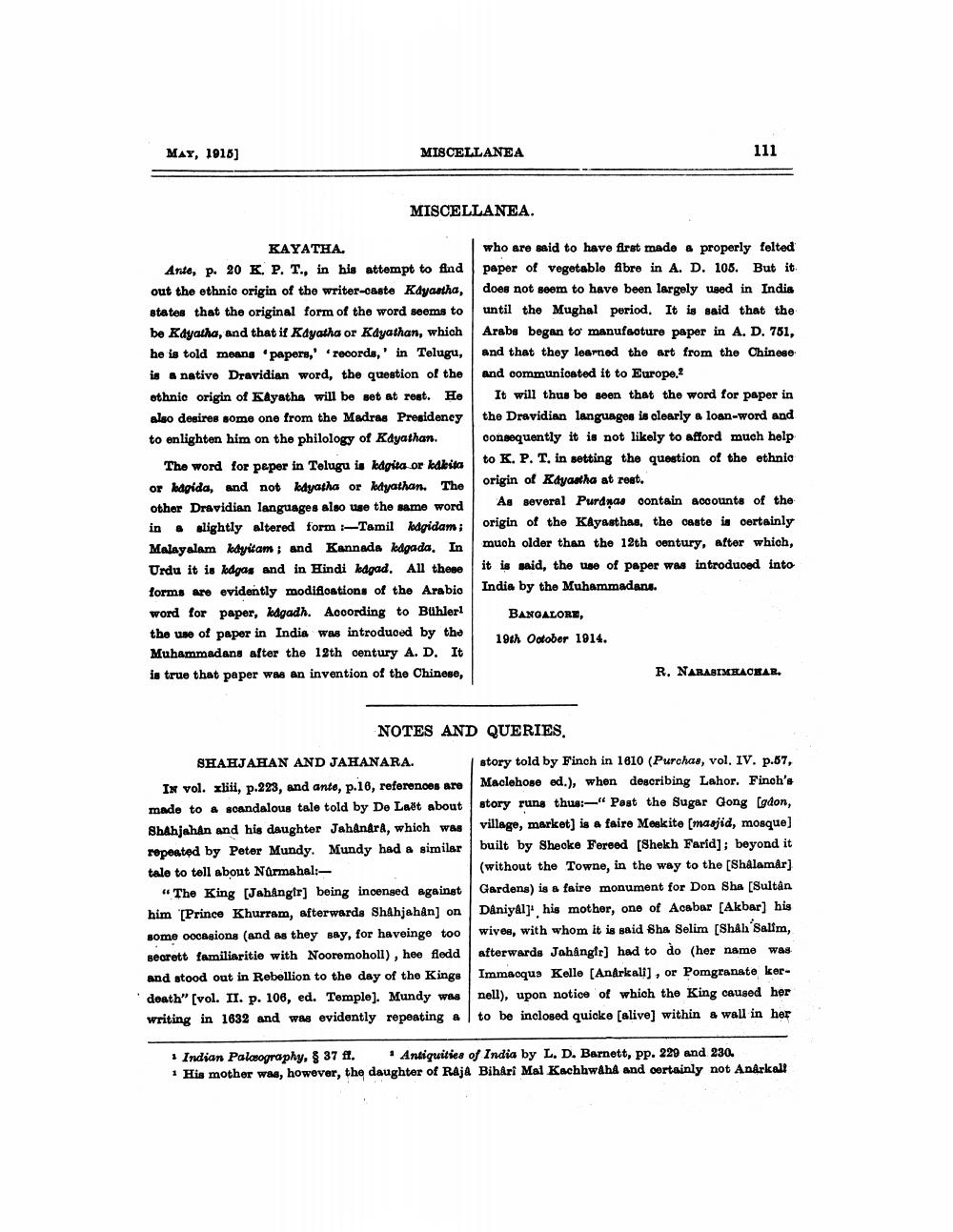________________
May, 1918]
MISCELLANEA
111
MISCELLANEA.
KAYATHA. Ante, p. 20 K, P. T., in his attempt to find out the ethnic origin of the writer-caste Kdyaatha, states that the original form of the word sooms to be Kayatha, and that if Kdyatha or Kayathan, which he is told meang 'papers, records,' in Telugu, is a native Dravidian word, the question of the othnic origin of Kayatha will be set at rost. He also desires some one from the Madras Presidency to enlighten him on the philology of Kdyathan.
The word for peper in Telugu is kapita or kaleita or hagida, and not lodyatha or Madyathan. The other Dravidian languages also use the same word in & slightly altered form -Tamil kagidam; Malayalam kayitam; and Kannada kdgada. In Urdu it is kdgas and in Hindi kagad. All these forms are evidently modifloations of the Arabio word for paper, kdgadh. According to Buhler1 the use of paper in India was introduoed by the Muhammadans after the 12th century A. D. It is true that paper was an invention of the Chinese,
who are mid to have first made a properly felted paper of vegetable Abre in A. D. 106. But it does not seem to have been largely used in India until the Mughal period. It is said that the Arabs began to manufacture paper in A. D. 761, and that they learned the art from the Chinese and communicated it to Europe.?
It will thus be seen that the word for paper in the Dravidian languages is clearly a loan-word and consequently it is not likely to afford much help to K. P, T, in setting the question of the ethnic origin of Kayastha at regt.
As several Purdnas contain accounts of the origin of the Kayasthas, the caste is certainly muoh older than the 12th century, after which, it is said, the use of paper was introduoed into India by the Muhammadans.
BANGALORE, 19th October 1914.
R. NARASIMHACKAR.
NOTES AND QUERIES, SHAHJAHAN AND JAHANARA. story told by Finch in 1810 (Purchas, vol. IV. p.67, Ix vol. xlii, p.223, and ante, p.18, reforences are Macleoso ed.), when describing Lahor. Finoh's made to a scandalous tale told by De Laßt about story runs thus:-" Past the Sugar Gong [gdon, ShAhjahan and his daughter Jahanara, which was village, market) is a faire Meskite (masjid, mosque) repeated by Peter Mundy. Mundy had a similar built by Shecke Fereed (Shekh Farid); beyond it tale to tell about Narmahal:
(without the Towne, in the way to the [Shalamar) "The King (Jahangir] being incensed against Gardens) is a faire monument for Don Sha (Sultan him [Prince Khurram, afterwards Shahjahan) on Daniyalj, his mother, one of Acabar (Akbar] his some occasions (and as they say, for haveingo too wives, with whom it is said Sha Selim (Shah Salim, secrett familiaritie with Nooromoholl), hee flodd afterwards Jahangfr) had to do (her name was and stood out in Rebellion to the day of the Kings Immacqua Kelle (Anarkali), or Pomgranate kerdeath" (vol. II. p. 106, ed. Temple). Mundy was nell), upon notion of which the King caused her writing in 1632 and was evidently repeating a to be inclosed quicke (alive) within a wall in her
1 Indian Palcography, 8 37 ft. Antiquities of India by L. D. Barnett, pp. 220 and 230. 1 His mother was, however, the daughter of Raja Bihári Mal Kachhwahl and certainly not Anarkall




